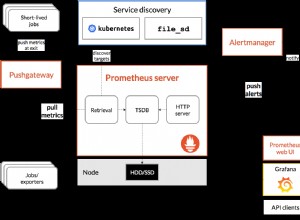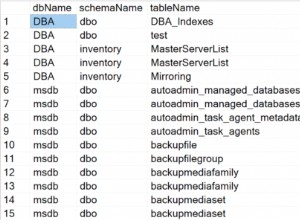Puede hacer que la búsqueda del camino sea más eficiente si comienza desde abajo. Empiece por los niños. Si comienza en el padre, implica atravesar todos los hijos; mientras que si buscó desde el niño, solo tiene un padre, por lo tanto, no perderá tiempo en encontrar la ruta entre el origen y el destino.
with recursive find_parent(source, target, recentness) as
(
select source, target, 0
from tbl
where target = 9
union all
select i.source, i.target, fp.recentness + 1
from tbl i
join find_parent fp on i.target = fp.source
),
construct_path(source, target, recentness, path) as
(
select source, target, recentness, source || '.' || target
from find_parent
where recentness = (select max(recentness) from find_parent)
union
select dd.source, dd.target, dd.recentness, cp.path || '.' || dd.target
from find_parent dd
join construct_path cp on dd.recentness = cp.recentness - 1
)
select source, target, path
from construct_path
order by recentness desc
Salida:
SOURCE TARGET PATH
1 2 1.2
2 4 1.2.4
4 9 1.2.4.9
Prueba en vivo:http://www.sqlfiddle.com/#!1/13e6b/1
Similar a esto:Cómo hacer que el padre tenga un hijo en SQL SERVER 2005
Esto está optimizado, corte la recursividad al padre si ya encuentra el específico (fuente).
Fuente =2
Objetivo =9
with recursive find_parent(source, target, recentness) as
(
select source, target, 0
from tbl
where target = 9
union all
select i.source, i.target, fp.recentness + 1
from tbl i
join find_parent fp on i.target = fp.source
-- despite the name, this target is another one's source
and i.target <> 2
)
,construct_path(source, target, recentness, path) as
(
select source, target, recentness, source || '.' || target
from find_parent
where recentness = (select max(recentness) from find_parent)
union
select dd.source, dd.target, dd.recentness, cp.path || '.' || dd.target
from find_parent dd
join construct_path cp on dd.recentness = cp.recentness - 1
)
select source, target, path
from construct_path
order by recentness desc
Salida:
SOURCE TARGET PATH
2 4 2.4
4 9 2.4.9
Prueba en vivo:http://www.sqlfiddle.com/#!1/13e6b/16




